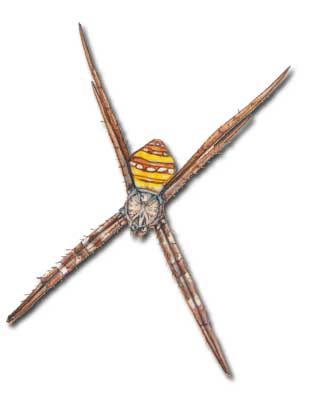GOLDEN ORB(Nephillia)
 Golden Orb spiders build huge golden silky wheel webs that are remarkably strong and often strung between small trees in woodlands and gardens. The female spiders are large and can often span the width of an adult’s hand.
Female Golden Orb spiders are characterized by the yellow bands that run around the joints of their black legs. Their slender body is a yellow-brown to silver-grey color. These spiders eat insects – even cicadas.
Golden Orb spiders build huge golden silky wheel webs that are remarkably strong and often strung between small trees in woodlands and gardens. The female spiders are large and can often span the width of an adult’s hand.
Female Golden Orb spiders are characterized by the yellow bands that run around the joints of their black legs. Their slender body is a yellow-brown to silver-grey color. These spiders eat insects – even cicadas.
Bites from these spiders can be quite painful, and usually only occur if harshly provoked. NET-CASTING (Deinopidae)
 Net Casting Spiders literally throw a net over their prey as it walks below them. These spiders will hang down from twigs or grass, combing their coils of tangled silk, awaiting suitable prey to approach. The spider will eat then cast the net, and envelop the prey.
Net Casting spiders have a stick-like appearance with very long legs that are often grouped into pairs, similar to the St. Andrew’s Cross Spider.
Net Casting Spiders literally throw a net over their prey as it walks below them. These spiders will hang down from twigs or grass, combing their coils of tangled silk, awaiting suitable prey to approach. The spider will eat then cast the net, and envelop the prey.
Net Casting spiders have a stick-like appearance with very long legs that are often grouped into pairs, similar to the St. Andrew’s Cross Spider.
Net Casting spiders are thought to be completely harmless to humans.
ST. ANDREW’S CROSS (Argiope Keyserlingi)
 The female of this spectacular species of spider is characterized by the colorful silver and red/orange bands that cover her body. She often weaves a web with a cross in the center. Here she will sit with adjacent pairs of legs together to form a cross. When threatened, the St Andrew’s Cross is able to shake her snare violently so that the whole web glimmers and she becomes a blur.
As with many species of spider, the male risk losing their lives if they attempt to mate with a not too willing female.
The female of this spectacular species of spider is characterized by the colorful silver and red/orange bands that cover her body. She often weaves a web with a cross in the center. Here she will sit with adjacent pairs of legs together to form a cross. When threatened, the St Andrew’s Cross is able to shake her snare violently so that the whole web glimmers and she becomes a blur.
As with many species of spider, the male risk losing their lives if they attempt to mate with a not too willing female.
If bitten, symptoms may include swelling, nausea, and dizziness.
WOLF (Lycosa)
 These drab colored, but often strikingly patterned spiders use their large, strong legs to run potential prey down. They may even run out onto the water in an attempt to catch their victim. The male Wolf Spider will use the unusual courting behavior of waving his front legs about as if he is the conductor of an orchestra.
These drab colored, but often strikingly patterned spiders use their large, strong legs to run potential prey down. They may even run out onto the water in an attempt to catch their victim. The male Wolf Spider will use the unusual courting behavior of waving his front legs about as if he is the conductor of an orchestra.
Once, fertilized, the female lays her eggs in a silken ball which remains attached to her spinnerets. After the eggs hatch, the spiderlings ride for a period of time on their mum’s back.

